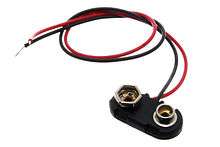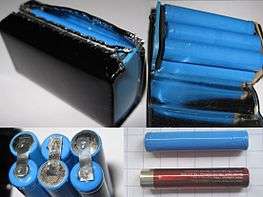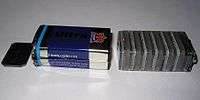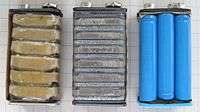Nine-volt battery

The nine-volt battery, or 9-volt battery, in its most common form was introduced for the early transistor radios. It has a rectangular prism shape with rounded edges and a polarized snap connector at the top. This type is commonly used in walkie talkies, clocks and smoke detectors.
The nine-volt battery format is commonly available in primary carbon-zinc and alkaline chemistry, in primary lithium iron disulfide, and in rechargeable form in nickel-cadmium, nickel-metal hydride and lithium-ion. Mercury-oxide batteries of this format, once common, have not been manufactured in many years due to their mercury content. Designations for this format include NEDA 1604 and IEC 6F22 (for zinc-carbon) or MN1604 6LR61[1] (for alkaline). The size, regardless of chemistry, is commonly designated PP3 - a designation originally reserved solely for carbon-zinc[2] - or in some countries, E or E-block.[3]
Most nine-volt alkaline batteries are constructed of six individual 1.5V LR61 cells enclosed in a wrapper.[4] These cells are slightly smaller than LR8D425 AAAA cells and can be used in their place for some devices, even though they are 3.5 mm shorter. Carbon-zinc types are made with six flat cells in a stack, enclosed in a moisture-resistant wrapper to prevent drying. Primary lithium types are made with 3 cells in series.[5]
In 2007, 9-volt batteries accounted for 4% of alkaline primary battery sales in the US. In Switzerland in 2008, 9-volt batteries totalled 2% of primary battery sales and 2% of secondary battery sales.[6][7]
Other nine-volt batteries of different sizes exist, such as the British "Ever Ready" PP series and certain lantern batteries.
Connectors

The battery has both terminals in a snap connector on one end. The smaller circular (male) terminal is positive, and the larger hexagonal or octagonal (female) terminal is the negative contact. The connectors on the battery are the same as on the connector itself; the smaller one connects to the larger one and vice versa.[4] The same snap-style connector is used on other battery types in the Power Pack (PP) series. Battery polarization is normally obvious since mechanical connection is usually only possible in one configuration. A problem with this style of connector is that it is very easy to connect two batteries together in a short circuit, which quickly discharges both batteries, generating heat and possibly a fire.[8] Because of this hazard, 9-volt batteries should be kept in the original packaging until they are going to be used.[9] An advantage is that several nine-volt batteries can be connected to each other in series to provide higher voltages.
History
The PP3 appeared when portable transistorized radio receivers became common, and is still called a "transistor" battery by some manufacturers. The Eveready company claims that it introduced this battery type in 1956.[10] Early transistorized radios and other equipment needed a suitable voltage miniature battery, but the commonly available small batteries at that time was either too low voltage or too high. The 22.5V battery made for vacuum tube/thermionic valve hearing aids and for photo flash bulbs was at the upper limit of the transistor voltage ratings, for instance.
Technical specifications




The most common type of 9V battery is commonly referred to simply as 9-volt, although there are less common 9V batteries of different sizes. Codes for the usual size include PP3 (for size and voltage, any technology), 6LR61 (IEC code for alkaline batteries), and in Japan 006P.[2]
The PP3 size battery has height 48.5 mm, width 26.5 mm, depth 17.5 mm (or 1.9 in × 1.0 in × 0.68 in). Both terminals are at one end and their centers are 1⁄2 inch (12.7 mm) apart.
Inside an alkaline or carbon-zinc 9-volt battery there are six cylindrical or flat cells connected in series. Some brands use welded tabs internally to attach to the cells, others press foil strips against the ends of the cells.
Rechargeable nickel–cadmium (NiCd) and Nickel-metal hydride (NiMH) batteries of nominal 9V rating have between six and eight 1.2 volt cells. Lithium ion versions typically use two cells (3.7-4.2V nominal each). There are also lithium polymer and low self-discharge NiMH versions.
Mercury batteries were formerly made in this size. They had higher capacity than the then-standard carbon-zinc types, a nominal voltage of 8.4 volts, and very stable voltage. Once used in photographic and measuring instruments or long-life applications, they are no longer manufactured as mercury is an environmental pollutant.
| Type | IEC name[11] |
ANSI/NEDA name[12] |
Typical capacity in mAh[2] |
Nominal voltage | |||
|---|---|---|---|---|---|---|---|
| Primary (disposable) | Alkaline | 6LR61 | 1604A | 550 | 9 | ||
| Zinc–carbon | 6F22 | 1604D | 400 | ||||
| Lithium | 1604LC | 1200 | 9.6 | ||||
| Rechargeable | NiCd | 6KR61 | 11604 | 120 | 7.2 | 8.4 (some) | |
| NiMH | 6HR61 | 7.2H5 | 175-300 | 7.2 | some | ||
| 8.4 | 9.6 | ||||||
| Lithium polymer | 520 | 7.4 | |||||
| Lithium-ion | 620 | 7.4 | |||||
Devices that use these batteries are generally designed to work until the voltage drops to an end point of typically 5.4 V.[13]
Self-discharge
Alkaline and lithium batteries self-discharge much more slowly than the older zinc-carbon type. An alkaline battery that is not used, or used in extremely low current applications such as backup, can be expected to last for approximately 6 years.
Testing and Charging
Most battery voltage testers and chargers that can also test 9V need another snap clip to hold the battery, while cylindrical batteries often share a holder that maybe adjustable in size. Because of the proximity of the positive and negative terminals at the top of the battery and relatively low current of most common batteries, one informal method of testing voltage is to place the two terminals across a tongue. A strong tingle would indicate a battery with a strong charge, the absence, a discharged battery. While there have been stories circulating of unfortunate outcomes, the process is rarely dangerous under normal circumstances, though it may be unpleasant.[14]
Lithium 9V/PP3
Lithium 9-volt batteries are consumer-replaceable, disposable high energy density batteries. In PP3 size they are typically rated at 0.8-1.2Ah (e.g., >1.2Ah @ 900 ohms to 5.4V @ 23 °C for one type),[2][15] about twice the capacity of alkaline batteries. Manufacturers claim "High energy density, up to 5x more than alkaline".[15] Lithium PP3 batteries have a long shelf life of up to 10 years. Common applications for lithium 9-volt batteries are smoke and carbon monoxide (CO) alarms, and electronic parking meters.
Other nine-volt batteries

There were several other sizes of nine-volt batteries. Two are still available, the PP7 and PP9. These date from the days of early transistor radios and are now less common than PP3. The PP4, PP5, PP6, PP10 and PP11 (this last battery was actually a 4.5+4.5 volt battery) sizes have long been obsolete. There was no PP2 size, and the PP1 and PP8 were 6 volt (the latter, still available, being designed for electric fence use). In the days of valve radios which used batteries designed specifically for vacuum tubes, there was a nine-volt grid bias battery or (US) 'C' battery which had tappings for various voltages between 1.5 and 9.
See also
References
- ↑ Duracell Catalogue or IEC
- 1 2 3 4 Details of batteries available currently are listed in many distributors' Web sites. For example, on the Farnell site searching "Home>Batteries & Chargers > Batteries - Non-Rechargeable, or Batteries - Rechargeable" for "PP3" will list several batteries in this size, with full details, from several manufacturers. The list will change from time to time.
- ↑ https://daily-max.en.alibaba.com/product/465337733-213594615/6LR61_9V_E_size_Alkaline_Battery.html
- 1 2 IEC 60086-2-2011 §7.6.1.12
- ↑ https://www.cpsc.gov//PageFiles/116967/LithiumFinal.pdf
- ↑ Life Cycle Impacts of Alkaline Batteries with a Focus on End-of-Life - EPBA-EU
- ↑ INOBAT 2008 statistics.
- ↑ 9-volt Battery Safety, NFPA, retrieved 13 May 2014
- ↑ http://www.nh.gov/safety/divisions/firesafety/news/20120808-9-volt-batteries.html
- ↑ "Battery History". Energizer.com. Retrieved 2010-11-27.
- ↑ IEC 60086-2011 pt2-§7.6.1.12
- ↑ ANSI C18.1M Part 1 and C18.3M Part 1
- ↑ Duracell. "9V (6LR61) datasheet"
- ↑ The Science of Licking a 9V Battery
- 1 2 Farnell: datasheet for Ultralife U9VL-J-P 9V lithium manganese dioxide PP3-size battery
External links
- A Look Inside a 9 Volt Battery
- What charger should I use?
- Your guide to types of household batteries (AAA, AA, C, D, and 9V)
- Brand-neutral drawing of a 9 volt alkaline battery based on ANSI specifications
- Brand-neutral drawing of a 9 volt carbon–zinc battery based on ANSI specifications
- Brand-neutral drawing of a 9 volt lithium battery based on ANSI specifications
- Brand-neutral drawing of a 9 volt rechargeable battery based on ANSI specifications